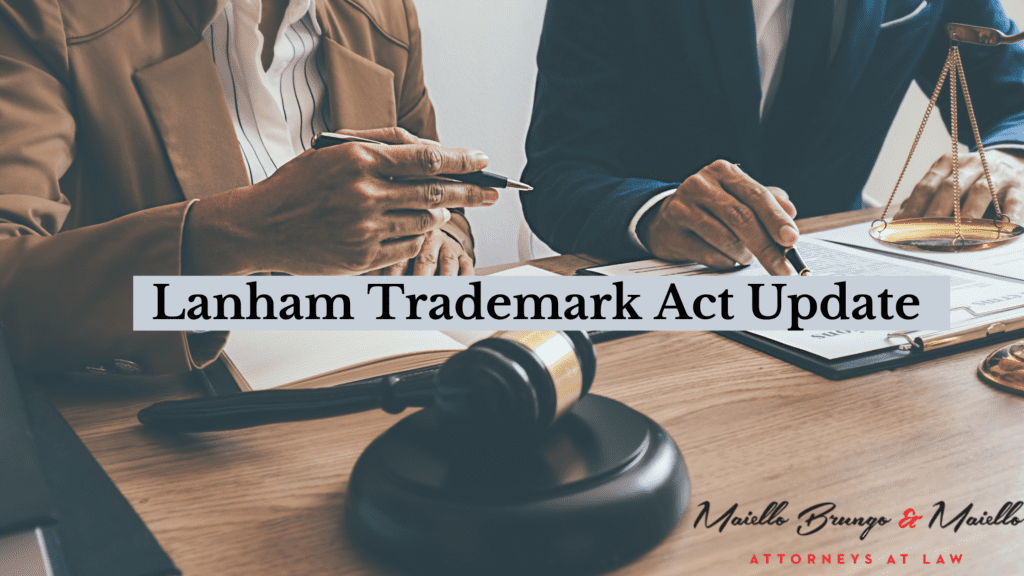As of December 18, 2021, the Trademark Modernization Act (the “TMA”) took effect after having become law in December of 2020. The Lanham Act protects registered marks by clearing away unused ones. This also helps make the trademark registration process more efficient.
Lanham Act Summary
In response to increased trademark application filings (almost 40% over the last five years) and the fact that many of these applications contain overly broad descriptions or are fraudulent in some manner such as having digitally altered specimens, the Lanham Act was amended to create new mechanisms to challenge and cancel marks.
The TMA strengthens a trademark owner’s ability to fight infringers and provides new means to challenge pending trademark applications and registrations.
What Does the Lanham Act Protect?
The TMA amends federal trademark law in several ways for trademark owners, including:
- Restoring the rebuttable presumption of irreparable harm to obtain injunctive relief for a trademark violation in trademark infringement litigation;
- Providing new procedures for canceling fraudulent trademark registrations; and
- Formalizing processes in trademark prosecution before the US Patent and Trademark Office (USPTO).
Retroactive Consequences of New Lanham Act Changes
For already-registered marks, the TMA provides new ex parte expungement and reexamination proceeding procedures to cancel and remove trademarks. As ex parte matters, the owner of the trademark does not need to be notified that proceedings have been initiated until receiving a request for information and/or evidence regarding the use of the trademark (the “Office Action”).
Expungement proceedings request cancellation based on evidence that a trademark was never used in commerce and may be initiated by the Director or a third-party at any point between three and 10 years from the date of registration. If the petitioner is a third-party, there is no need for there to be any standing. The potential for inappropriate use of expungement proceeding requests by third parties is tempered by the requirement that the Director must review the request and has the discretion to elect to move forward. If the Director elects to proceed, an Office Action is sent to the owner and the owner has three months in which to provide evidence of use of the trademark. This evidence is the same as would be submitted when submitting an initial application for registration.
Reexamination hearings are the same as expungement hearings except that they must be filed within the first five years of registration and the petition must be based on evidence that the mark was not in use with the noted goods and/or services as of the dates of first use listed or the deadline for the filing of the Statement of Use.
The TMA Appeals Process
The TMA also provides new grounds for a petitioner requesting the cancelation of a registered trademark through the Trademark Trial and Appeal Board (“TTAB”). The TTAB is a neutral body that functions like a court for trademark matters within the USPTO and handles appeals involving applications, expungement and reexamination hearings, and trials. The TMA broadened the grounds available for cancelation to include that the trademark was never in use in addition to abandonment and nonuse. The petition can be filed after three years from the date of registration and the TTAB practices and procedures are followed.
For marks that have yet to be registered, letters of protest, which before were merely part of the administrative process, are now statutorily authorized pursuant to the TMA. Letters of protest allow protesters to submit letters, arguments, and up to 10 items of relevant, objective evidence against a trademark application to support a refusal to register. If the USTPO determines sufficient evidence exists, this evidence is provided to the Examining Attorney reviewing the application and he or she must consider the same when acting on the application.
Next, due to a split in the various federal courts, the TMA amended the Lanham Act to add rebuttable presumption of irreparable harm upon a finding of infringement with respect to a permanent injunction or a likelihood of success on the merits for a preliminary injunction. Typically, it had been the case that an owner seeking injunctive relief to stop a defendant from using a trademark was granted a presumption of irreparable harm once he or she showed a likelihood of confusion between the trademarks. However, in 2006, the Supreme Court held that a patent holder must prove irreparable harm to obtain an injunction. Based on this patent case, the federal courts were undecided as to whether the same decision applied to trademarks. Reinstating the presumption for all courts and including it as part of the statute, the TMA makes it easier for owners to obtain injunctions to enforce trademark rights.
Finally, in an effort to streamline the review process and lessen the delay of owners waiting to obtain registrations or responses to post-registration events, the period in which to respond to Office Actions has been shortened from six months to three months. If necessary, owners may request one three-month extension upon request and payment of a fee. Due to upgrades needed to USPTO technology systems, the shortened response time will not go into effect until December 1, 2022.
Contact a Litigation Lawyer For More Information
Trademark owners should consult with their legal counsel to understand how the TMA affects them and the enforcement of their intellectual property rights. Call attorney Jennifer Cerce for solutions to all of your trademark and copyright concerns


